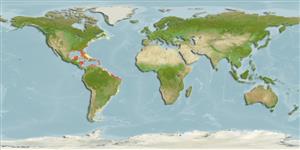Anthozoa |
Alcyonacea |
Anthothelidae
Environment: milieu / climate zone / depth range / distribution range
Ecology
Reef-associated; depth range 0 - 25 m (Ref. 83916). Tropical
Western Atlantic.
Length at first maturity / Size / Weight / Age
Maturity: Lm ? range ? - ? cm
Maximum depth recorded from Belize (Ref. 87218) Inhabit a variety of reef environments throughout the Caribbean (Ref. 415), at depths of 0.5 to 12 m in coral reefs and rocky bottoms (Ref. 83916). Also found in Carrie Bow Cay, Belize in lagoon and back reef, reef crest, low spur and groove zone, outer ridge and fore-reef slope at depths of up to 25 m (Ref. 87218).
Life cycle and mating behavior
Maturity | Reproduction | Spawning | Eggs | Fecundity | Larvae
Members of the class Anthozoa are either gonochoric or hermaphroditic. Mature gametes are shed into the coelenteron and spawned through the mouth. Life cycle: The zygote develops into a planktonic planula larva. Metamorphosis begins with early morphogenesis of tentacles, septa and pharynx before larval settlement on the aboral end.
Collin, R., M.C. Díaz, J. Norenburg, R.M. Rocha, J.A. Sánchez, M. Schulze, A. Schwartz and A. Valdés. 2005. (Ref. 415)
IUCN Red List Status (Ref. 130435)
CITES status (Ref. 108899)
Not Evaluated
Not Evaluated
Threat to humans
Human uses
| FishSource |
Tools
More information
Age/SizeGrowthLength-weightLength-lengthMorphologyLarvaeAbundance
Internet sources
Estimates based on models
Preferred temperature
(Ref.
115969): 13.7 - 28.1, mean 27.2 (based on 792 cells).
Price category
Unknown.
